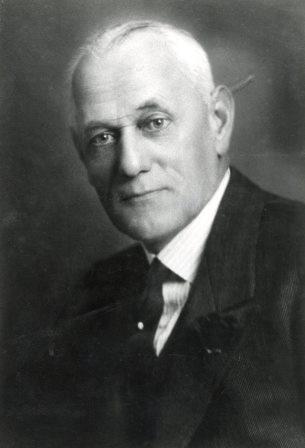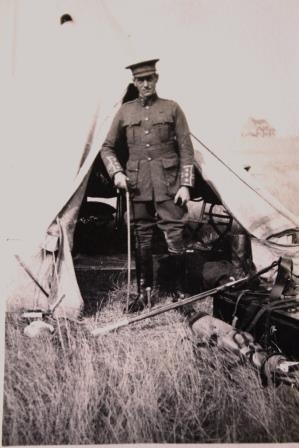In this next series of blog posts I aim to show how archival research on a single subject or person often opens up an Aladdin’s cave of equally fascinating historical avenues and tangents. The wealth of contextual documents contribute to forming a more holistic picture of a person and they times the lived in.

In 1962, Basil Morson, Consultant Pathologist at St Mark’s, working on a possible history of the hospital, interviewed Peggy Pollen, née Wallis, eldest daughter of Sir Frederick Wallis, rectal specialist. He reported what she said about Gordon-Watson:
“Charles Gordon Watson was a very fiery character and used to drink very heavily. He was an orphan. Wallis was very kind to him and gradually pulled him up and got him to drink less. ‘A nice queer sort of creature’. He married rather late in life and had two sons and became a Roman Catholic.”
Perhaps unintentionally scurrilous (and factually incorrect – he was not an orphan and had only one son) this titbit whet my appetite to learn more about Charles Gordon Watson, who changed his named to Charles Gordon Gordon–Watson by deed poll in 1920, and to square it with the words of Lionel Norbury, OBE FRCS, who knew and worked with him at St Mark’s Hospital:
“…a kindly and courteous gentleman, an enthusiast, sportsman, soldier, a bold and courageous surgeon and a pioneer in certain fields of research.” (Norbury delivering the first Gordon-Watson Memorial Lecture instituted by the Royal College of Surgeons of England in 1960)
Like its founder Frederick Salmon and many St Mark’s surgeons before and after him, Gordon-Watson was also a ‘Bart’s man’, studying at the Medical School, qualifying 1898, and going on to hold a number of teaching and surgical posts at St Bartholomew’s Hospital.

As a result, the St Bartholomew’s Hospital Archive holds some compelling material generated by him relating to his military, medical and social life from the mid-1890s to the late 1930s. From this we can draw our own conclusions, and perhaps form some vivid impressions.
Gordon-Watson entered the Medical School of St Bartholomew’s Hospital as a last resort, having failed to get into Oxbridge. Although forced, in addition, to rule out professional soldiering as a financially unviable career, he joined the Volunteers before qualifying and was subsequently able to combine the military life-style he aspired to with his medical calling. His army experiences are conveyed in three fascinating albums of photographs and ephemera compiled by Gordon-Watson and donated to St Bartholomew’s Hospital Archives by his son Brigadier Michael Gordon-Watson around 1959/60 (SBHPP/CGW/2-4).
The Second Boer War 1899-1901
As a civil surgeon in South Africa 1899-1901, during the Boer War, Gordon-Watson served under Anthony Bowlby and Howard H. Tooth, both of St Bartholomew’s, and was awarded the Queen’s South Africa Medal with three clasps.
In a reference for the St Bartholomew’s Hospital post to which Gordon-Watson was appointed in 1910, G. H. Makins, FRCS, of St Thomas’s Hospital, who he met during the Boer War, stated:
“… Mr Watson showed himself an able surgeon, skillful with his hands, enthusiastic, and possessed of good judgment.” (SBHB/HA/45/2/8).
The second chapter of Gordon-Watson’s unpublished autobiography (SBHPP/CGW/1) covers his experiences, including the journey to Wynberg in Capetown, and work at the hospital there treating and operating on wounded British and Boer soldiers.


By all accounts Gordon-Watson enjoyed his stint in South Africa and when away from medical tasks he took full advantage of sporting opportunities such as polo and horse-racing.

Other leisure activities included pony-trekking and climbing Table Mountain. He also found time to set up the South African Civil Surgeons’ Dinner with Sir Francis Fremantle, which was held annually for many years.
Left, medical colleagues in South Africa (Gordon-Watson centre of back row); top right the Wynberg hospital, bottom right local ladies (SBHPP/CGW/2 & 3)
On return to England Gordon-Watson was commissioned as surgeon to the 3rd Middlesex Royal Garrison Artillery Volunteers, transferring as Captain RAMC to the Territorial Army when it was set up in 1908. By the end of that year he held posts in both St Bartholomew’s and St Mark’s hospitals.

First World War 1914-1918
Gordon-Watson was eager to get out to France when war broke out in Summer 1914. He helped to establish the Duchess of Westminster’s Voluntary hospital at Le Touquet, a small town on the coast of Northern France south of Calais and Boulogne. In November 1914 he was promoted Lieutenant-Colonel in charge of the hospital which was subsequently re-named No.1 Red Cross Hospital.
Although Chapter 3 of Gordon-Watson’s unpublished autobiography (SBHPP/CGW/1) records details of setting up at Le Touquet, apart from recording his promotion in November 1916 as Consulting Surgeon to the Second Army in France, promotion to Colonel and move to the British Army in Italy, there is frustratingly no account of his experiences between 1914-1918 including at the front line where he served for at least two years.





What were his exact thoughts and feelings in the thick of war and looking back? We can only speculate. However the many published and unpublished accounts and memoirs of medical men and women during the First World War allow us to imagine the sights, noises and smells that Gordon-Watson must have encountered. Early on he recognised the syndrome of ‘trench frost-bite’. He was a warm advocate of ‘bipping’ wounds – smearing ‘Bipp’ paste, a mixture of bismuth, iodoform and paraffin paste, over severe injuries to cleanse and prevent infection. He undoubtedly gained a great deal of operative and amputation experience and learnt the art of speedy surgery in highly stressful surroundings (which surely came in handy in the operating theatre of St Mark’s hospital).
He suffered the deaths of family members, including a brother H. C. Watson, friends and colleagues, many of which are recorded in his albums SBHPP/CGW/3 & 4.

Nevertheless, it was not all blood, guts and death. In his role, Gordon-Watson showed Edward Prince of Wales around one of the Duchess of Westminster’s hospital in Jan 1915.

And there must have been romance. At the age of 43 Gordon-Watson married Alice Gwendoline Mary Teevan in 1917. There is a large studio portrait of a bride in one of his albums however I have been unable to confirm that it is Alice.
Perhaps, even in war time, there were opportunities for sight-seeing when on leave. Two of Gordon-Watson’s albums contain tourist souvenir prints of Carcassone Castle in southern France, statues in Rome and Florence museums and the church of San Zeno in Verona…

Next week I will examine Gordon-Watson’s career at St Mark’s and St Bartholomew’s hospitals, his favorite surgical techniques and his experimentation with radium for various types of cancer.



